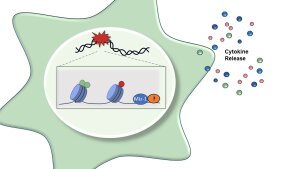Molecular mechanisms linking adaptive DNA damage response (DDR) to immune cellactivation and inflammation
SP13 Transcriptional regulation of macrophage immunity and maturation by Miz-1
SP13 klein
Picture: SP13Project leader: Christian Kosan
Doctoral candidate: Nina Henning
Background and previous work:
Upon DNA damage, cells respond in different ways. They induce apoptosis, transient cell cycle arrest or cellular senescence, but how this is controlled is still enigmatic. Interestingly, recent studies showed a crucial role of DNA damage sensors (e.g. ATM) in promoting immune response. This is in line with a recent study showing that low-dose DNA damage protects from severe sepsis and this is controlled by ATM (ataxia telangiectasia mutated) kinase and the induction of autophagy (Figueiredo et al., 2013). Nevertheless, there are several studies showing also an induction of inflammatory cytokines and activation of the NF-κB-pathway in innate immune cells by DNA damage sensors (Nakad and Schumacher 2016).
We have recently shown that the transcription factor “Myc interacting zinc finger protein 1” (Miz-1) regulates cellular DDR in several ways. During V(D)J recombination, Miz-1 regulates the expression of the ribosomal protein Rpl22 and thereby controls the translation of the tumor-suppressor p53. Besides, Miz-1-deficient lymphocytes show an upregulation of the negative cell cycle regulator p21 and a strong increase of apoptotic as well as senescent cells (Rashkovan et al., 2014).
Miz-1 also controls inflammatory signalling pathways by regulating gene expression of the pro-inflammatory factor C/EBPδ by interacting with HDAC1. Here, Miz-1 deletion leads to an up-regulation of this pro-inflammatory mediator and an overshooting immune-response of lung epithelial cells (Do-Umehara et al., 2013). In addition, we could show that Miz-1 is able to associate with the NF-κB subunit p65, a key transcription factor in inflammation.
Specific aims and working programme:
We want to obtain a deeper understanding of the complexity of Miz-1 function within macrophage immunity and maturation. For this purpose, we are using a mouse model carrying a conditional deletion of functional Miz-1 in the myeloid lineage (LysM-Cre x Miz-1fl/fl) to trace its importance alongside myelopoiesis.
Aim1: Immune phenotyping of Miz-1 depleted mice to estimate the importance of Miz-1 for myeloid immune cell maturation. Mature cell populations will be identified and characterized using flow cytometry analysis (FACS).
Aim2: Investigation of gene expression and epigenetic modifications of Miz-1 deficient cells after low-dose DNA damage. We will elaborate cytokine expression profiles of BMDMs as well as histone modifications induced by LPS stimulation and/or low dose γ-irradiation. ChIP experiments will reveal altered activating and repressing epigenetic marks and allow deeper insights into step-wise regulation of inflammatory gene expression.
Aim3: Elucidation of Miz-1 importance during PCI-induced sepsis after low-dose DNA damage. Sepsis will be induced in Miz-1 depleted mice using the peritoneal contamination and infection (PCI) model. Benefits of low-dose γ-irradiation will be determined by analysing survival rates, cytokine release and immune phenotype after intraperitoneal injection of stool suspensions.
